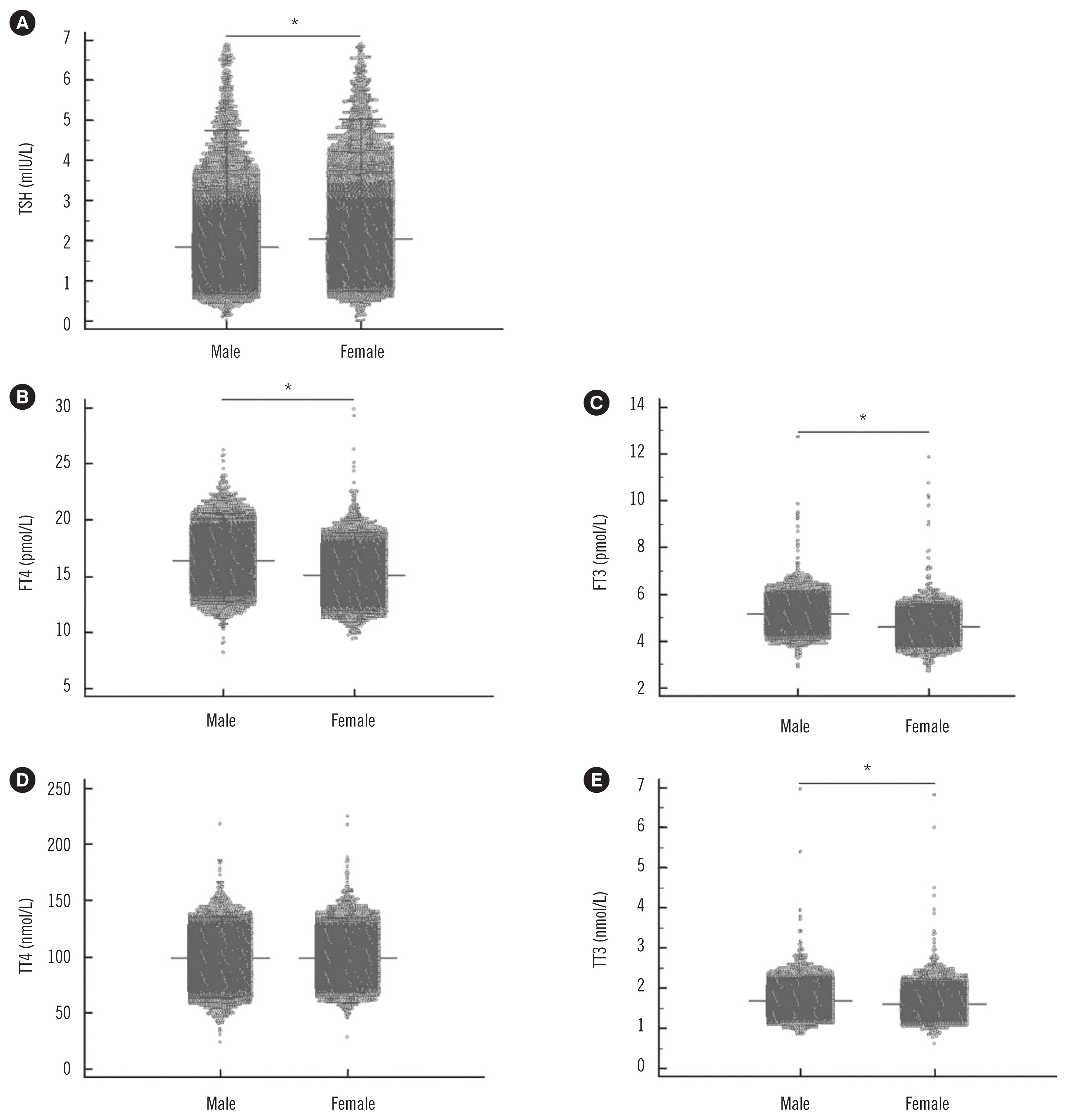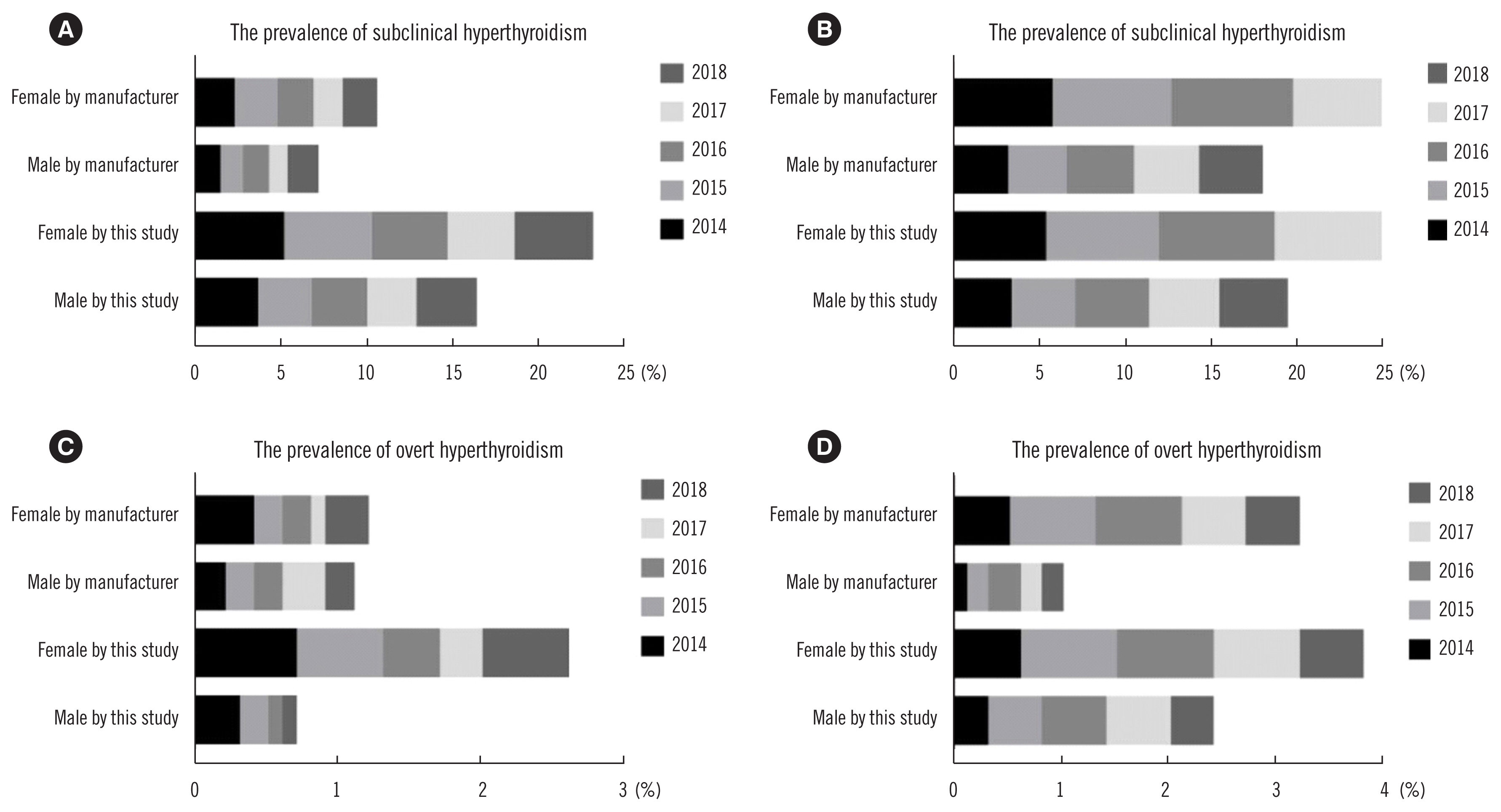Reference Intervals for Thyroid-Associated Hormones and the Prevalence of Thyroid Diseases in the Chinese Population
- Affiliations
-
- 1Department of Clinical Laboratory, Peking Union Medical College Hospital, Peking Union Medical College & China Academy of Medical Science, Beijing, China
- 2Department of Health Care, Peking Union Medical College Hospital, Peking Union Medical College & China Academy of Medical Science, Beijing, China
- 3Department of Endocrinology, Peking Union Medical College Hospital, Peking Union Medical College & China Academy of Medical Science, Beijing, China
- KMID: 2512736
- DOI: http://doi.org/10.3343/alm.2021.41.1.77
Abstract
- Background
Thyroid diseases are highly prevalent worldwide, but their diagnosis remains a challenge. We established reference intervals (RIs) for thyroid-associated hormones and evaluated the prevalence of thyroid diseases in China.
Methods
After excluding outliers based on the results of ultrasound screening, thyroid antibody tests, and the Tukey method, the medical records of 20,303 euthyroid adults, who visited the Department of Health Care at Peking Union Medical College Hospital from January 2014 to December 2018, were analyzed. Thyroid-associated hormones were measured by the Siemens Advia Centaur XP analyzer. The RIs for thyroid-associated hormones were calculated according to the CLSI C28-A3 guidelines, and were compared with the RIs provided by Siemens. The prevalence of thyroid diseases over the five years was evaluated and compared using the chi-square test.
Results
The RIs for thyroid stimulating hormone (TSH), free thyroxine (FT4), free triiodothyronine (FT3), total thyroxine (TT4), and total triiodothyronine (TT3) were 0.71–4.92 mIU/L, 12.2–20.1 pmol/L, 3.9–6.0 pmol/L, 65.6–135.1 nmol/L, and 1.2–2.2 nmol/L, respectively. The RIs of all hormones except TT4 differed significantly between males and females. The RIs of TSH increased with increasing age. The prevalence of overt hypothyroidism, overt hyperthyroidism, subclinical hypothyroidism, and subclinical hyperthyroidism was 0.5% and 0.8%, 0.2% and 0.6%, 3.8% and 6.1%, and 3.3% and 4.7% in males and females, respectively, which differed from those provided by Siemens.
Conclusions
Sex-specific RIs were established for thyroid-associated hormones, and the prevalence of thyroid diseases was determined in the Chinese population.
Keyword
Figure
Cited by 3 articles
-
Age Group-specific Reference Intervals for the Elecsys Anti-Müllerian Hormone Assay in Healthy Korean Women: a Nationwide Population-based Study
Misuk Ji, Kwang-Rae Kim, Hyun-Ki Kim, Woochang Lee, Yeo-Min Yun, Sail Chun, Won-Ki Min
Ann Lab Med. 2022;42(6):621-629. doi: 10.3343/alm.2022.42.6.621.Thyroid Hormone Reference Intervals among Healthy Individuals In Lanzhou, China
Yan Lu, Wen-Xia Zhang, De-Hong Li, Lian-Hua Wei, Yu-Jun Zhang, Fu-Na Shi, Shen Zhou
Endocrinol Metab. 2023;38(3):347-356. doi: 10.3803/EnM.2023.1638.Comparison of Thyroid-Stimulating Hormone Results from Eight Different Reagents and Assay-Specific Korean Reference Interval for Subclinical Hypothyroidism Treatment
Won Sang Yoo, Sollip Kim, Young Joo Park, Sang Hoon Song, Kyunghoon Lee, Eun Kyung Lee, Jehoon Lee, Ho-Young Lee, Yun Jae Chung, Hyun Kyung Chung, Jin Chul Paeng, Minje Han, Ho-Cheol Kang
Int J Thyroidol. 2023;16(2):166-174. doi: 10.11106/ijt.2023.16.2.166.
Reference
-
1. M⊘llehave LT, Linneberg A, Skaaby T, Knudsen N, Ehlers L, J⊘rgensen T, et al. Trends in costs of thyroid disease treatment in Denmark during 1995–2015. Eur Thyroid J. 2018; 7:75–83.
Article2. Selmer C, Olesen JB, Hansen ML, von Kappelgaard LM, Madsen JC, Hansen PR, et al. Subclinical and overt thyroid dysfunction and risk of all-cause mortality and cardiovascular events: A large population study. J Clin Endocrinol Metab. 2014; 99:2372–82.
Article3. Yan YR, Liu Y, Huang H, Lv QG, Gao XL, Jiang J, et al. Iodine nutrition and thyroid diseases in Chengdu, China: an epidemiological study. QJM. 2015; 108:379–85.
Article4. Biondi B, Cappola AR, Cooper DS. Subclinical Hypothyroidism: a review. JAMA. 2019; 322:153–160.5. Grasbeck R, Saris NE. Establishment and use of normal values. Scand J Clin Lab Invest. 1969; 26(S110):62–63.6. Wang Y, Zhang YX, Zhou YL, Xia J. Establishment of reference intervals for serum thyroid-stimulating hormone, free and total thyroxine, and free and total triiodothyronine for the Beckman Coulter DxI-800 analyzers by indirect method using data obtained from Chinese population in Zhejiang Province, China. J Clin Lab Anal. 2017; 31:e22069.7. Ehrenkranz J, Bach PR, Snow GL, Schneider A, Lee JL, Ilstrup S, et al. Circadian and circannual rhythms in thyroid hormones: determining the TSH and free T4 reference intervals based upon time of day, age, and sex. Thyroid. 2015; 25:954–61.
Article8. Giovannini S, Zucchelli GC, Iervasi G, Iervasi A, Chiesa MR, Mercuri A, et al. Multicentre comparison of free thyroid hormones immunoassays: the Immunocheck study. Clin Chem Lab Med. 2011; 49:1669–76.
Article9. Thienpont LM, Faix JD, Beastall G. Standardization of FT4 and harmonization of TSH measurements–a request for input from endocrinologists and other physicians. Endocr Pract. 2016; 22:374.10. Solberg HE. International Federation of Clinical Chemistry. Scientific committee, Clinical Section. Expert Panel on Theory of Reference Values and International Committee for Standardization in Haematology Standing Committee on Reference Values. Approved recommendation (1986) on the theory of reference values. Part 1. The concept of reference values. J Clin Chem Clin Biochem. 1987; 25:337–42.
Article11. Alexander EK, Pearce EN, Brent GA, Brown RS, Chen H, Dosiou C, et al. 2017 Guidelines of the American Thyroid Association for the diagnosis and management of thyroid disease during pregnancy and the postpartum. Thyroid. 2017; 27:315–89.
Article12. Hoffmann RG. Statistics in the practice of medicine. JAMA. 1963; 185:864–73.
Article13. Han L, Zheng W, Zhai Y, Xie X, Zhang J, Zhang S, et al. Reference intervals of trimester-specific thyroid stimulating hormone and free thyroxine in Chinese women established by experimental and statistical methods. J Clin Lab Anal. 2018; 32:e22344.
Article14. Milinković N, Ignjatović S, Žarković M, Jovičić S, Radosavljević B, Singh S, et al. Indirect estimation of age-related reference limits of thyroid parameters: A cross-sectional study of outpatients’ results. Scand J Clin Lab Invest. 2014; 74:378–84.
Article15. Clerico A, Trenti T, Aloe R, Dittadi R, Rizzardi S, Migliardi M, et al. A multicenter study for the evaluation of the reference interval for TSH in Italy (ELAS TSH Italian Study). Clin Chem Lab Med. 2018; 57:259–67.
Article16. Park SY, Kim HI, Oh HK, Kim TH, Jang HW, Chung JH, et al. Age- and gender-specific reference intervals of TSH and free T4 in an iodine-replete area: data from Korean National Health and Nutrition Examination Survey IV (2013–2015). Plos One. 2018; 13:e0190738.
Article17. Ali NI, Alamoudi AO, Adam I. Reference intervals of thyroid hormones in a previously iodine-deficient area in Darfur, Sudan. Ther Adv Endocrinol Metab. 2018; 9:293–7.
Article18. Tozzoli R, D’Aurizio F, Metus P, Steffan A, Mazzon C, Bagnasco M. Reference intervals for thyrotropin in an area of Northern Italy: the Pordenone thyroid study (TRIPP). J Endocrinol Invest. 2018; 41:985–94.
Article19. Hickman PE, Koerbin G, Simpson A, Potter JM, Hughes DG, Abhayaratna WP, et al. Using a thyroid disease-free population to define the reference interval for TSH and free T4 on the Abbott Architect analyser. Clin Endocrinol (Oxf). 2017; 86:108–12.
Article20. Barth JH, Spencer JD, Goodall SR, Luvai A. Reference intervals for thyroid hormones on Advia Centaur derived from three reference populations and a review of the literature. Ann Clin Biochem. 2016; 53:385–9.
Article21. Kim M, Kim TY, Kim SH, Lee Y, Park SY, Kim HD, et al. Reference interval for thyrotropin in a ultrasonography screened Korean population. Korean J Intern Med. 2015; 30:335–44.
Article22. Sriphrapradang C, Pavarangkoon S, Jongjaroenprasert W, Chailurkit LO, Ongphiphadhanakul B, Aekplakorn W. Reference ranges of serum TSH, FT4, and thyroid autoantibodies in the Thai population: The National Health Examination Survey. Clin Endocrinol (Oxf). 2014; 80:751–6.
Article23. Langén VL, Niiranen TJ, Mäki J, Sundvall J, Jula AM. Thyroid-stimulating hormone reference range and factors affecting it in a nationwide random sample. Clin Chem Lab Med. 2014; 52:1807–13.
Article24. Kutluturk F, Yildirim B, Ozturk B, Ozyurt H, Bekar U, Sahin S, et al. The reference intervals of thyroid stimulating hormone in healthy individuals with normal levels of serum free thyroxine and without sonographic pathologies. Endocr Res. 2014; 39:56–60.
Article25. Marwaha RK, Tandon N, Ganie MA, Mehan N, Sastry A, Garg MK, et al. Reference range of thyroid function (FT3, FT4 and TSH) among Indian adults. Clin Biochem. 2013; 46:341–5.
Article26. Völzke H, Schmidt CO, John U, Wallaschofski H, Dörr M, Nauck M. Reference levels for serum thyroid function tests of diagnostic and prognostic significance. Horm Metab Res. 2010; 42:809–14.
Article27. Ross HA, den Heijer M, Hermus AR, Sweep FC. Composite reference interval for thyroid-stimulating hormone and free thyroxine, comparison with common cutoff values, and reconsideration of subclinical thyroid disease. Clin Chem. 2009; 55:2019–25.
Article28. Barth JH, Luvai A, Jassam N, Mbagaya W, Kilpatrick ES, Narayanan D, et al. Comparison of method-related reference intervals for thyroid hormones: studies from a prospective reference population and a literature review. Ann Clin Biochem. 2018; 55:107–12.
Article29. Mirjanic-Azaric B, Avram S, Stojakovic-Jelisavac T, Stojanovic D, Petkovic M, Bogavac-Stanojevic N, et al. Direct estimation of reference intervals for thyroid parameters in the Republic of Srpska. J Med Biochem. 2017; 36:137–44.
Article30. Wang P, Gao YJ, Cheng J, Kong GL, Wang Y, Wu XY, et al. Serum thyroid hormone reference intervals in the apparently healthy individuals of Zhengzhou area of China. Genet Mol Res. 2014; 13:7275–81.
Article31. Zarković M, Cirić J, Beleslin B, Cirić S, Bulat P, Topalov D, et al. Further studies on delineating thyroid-stimulating hormone (TSH) reference range. Horm Metab Res. 2011; 43:970–6.
Article32. Çavuşoğlu AÇ, Bilgili S, Erkızan Ö, Arıcan H, Karaca B. Thyroid hormone reference intervals and the prevalence of thyroid antibodies. Turk J Med Sci. 2014; 40:665–72.33. Friis-Hansen L, Hilsted L. Reference intervals for thyreotropin and thyroid hormones for healthy adults based on the NOBIDA material and determined using a Modular E170. Clin Chem Lab Med. 2008; 46:1305–12.
Article34. Roelfsema F, Pereira AM, Veldhuis JD, Adriaanse R, Endert E, Fliers E, et al. Thyrotropin secretion profiles are not different in men and women. J Clin Endocrinol Metab. 2009; 94:3964–7.
Article35. Hollowell JG, Staehling NW, Flanders WD, Hannon WH, Gunter EW, Spencer CA, et al. Serum TSH, T(4), and thyroid antibodies in the United States population (1988 to 1994): National Health and Nutrition Examination Survey (NHANES III). J Clin Endocrinol Metab. 2002; 87:489–99.
Article36. Aoki Y, Belin RM, Clickner R, Jeffries R, Phillips L, Mahaffey KR. Serum TSH and total T4 in the United States population and their association with participant characteristics: National Health and Nutrition Examination Survey (NHANES 1999–2002). Thyroid. 2007; 17:1211–23.
Article37. Clerico A, Ripoli A, Fortunato A, Alfano A, Carrozza C, Correale M, et al. Harmonization protocols for TSH immunoassays: a multicenter study in Italy. Clin Chem Lab Med. 2017; 55:1722–33.
Article38. Boucai L, Hollowell JG, Surks MI. An approach for development of age-, gender-, and ethnicity-specific thyrotropin reference limits. Thyroid. 2011; 21:5–11.
Article39. Dold S, Zimmermann MB, Jukic T, Kusic Z, Jia Q, Sang Z, et al. Universal salt iodization provides sufficient dietary iodine to achieve adequate iodine nutrition during the first 1000 days: A cross-sectional multicenter study. J Nutr. 2018; 148:587–98.
Article40. Soh SB, Aw TC. Laboratory Testing in Thyroid Conditions-Pitfalls and Clinical Utility. Ann Lab Med. 2019; 39:3–14.
- Full Text Links
- Actions
-
Cited
- CITED
-
- Close
- Share
- Similar articles
-
- Interaction of thyroid hormones and prolactin in depression
- Thyroid dysfunction and subfertility
- Establishment of Trimester-Specific Reference Intervals for Thyroid Hormones in Korean Pregnant Women
- Evaluation of Thyroid Hormone Levels and Urinary Iodine Concentrations in Koreans Based on the Data from Korea National Health and Nutrition Examination Survey VI (2013 to 2015)
- Thyroid Hormone Reference Intervals among Healthy Individuals In Lanzhou, China



